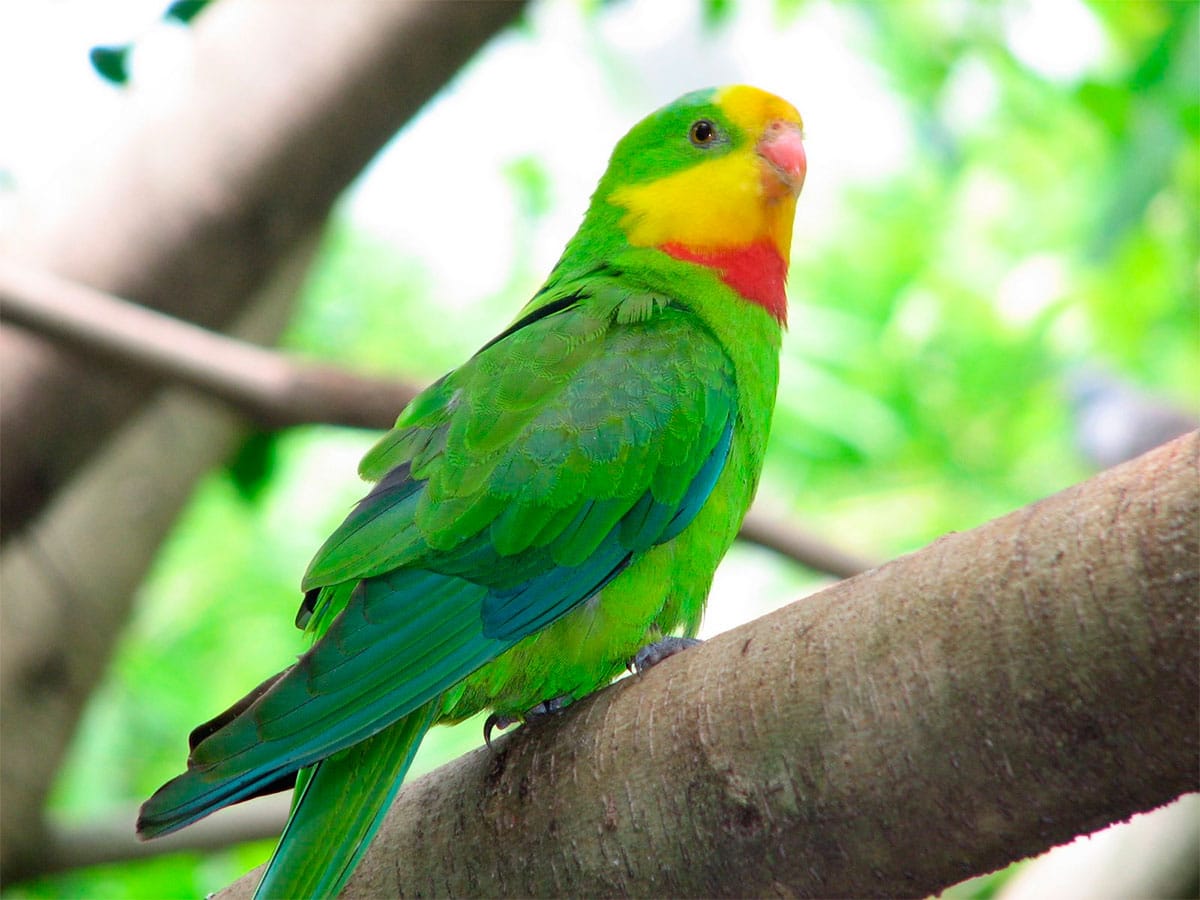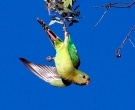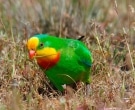Content
|
|---|
Description
40 cm.. length between 132 and 157 g. of weight.
The Superb parrot (Polytelis swainsonii) has the front, crown, Chin and throat of bright yellow; back of the bright green Crown with turquoise blue wash: headphones coverts and Lords, green. Bright green upper parts. Upper, the wings, bright green, with dark diffusion in the inner margins of the vane internal and blue diffusion in vane outer (fine yellow rear margin for flight feathers); bluish carpal edge: light blue primary coverts; primary elongated.
Wing of bright green feathers; bottom of blackish brown flight feathers. Underparts pale bright green, with thin bright red Ruff between throat yellow and green at the top of the chest. Upper, bright green tail, with dark elongated Central feathers Slightly bulbous tips. outer feathers with bluish edges vane outer. The lower part of the tail is black.
Bill, coral red; yellow-orange irises; Blackish legs.
The female is completely Green, with a bath pink Brown throat and with the headphones cinnamon and the Crown of blue-grey. The mantle is more off, more greenish Brown, contrasting with the Green rump and dark flight feathers. The underparts are paler, orange-red legs. She also has distinctive pink trim and pink tips to yellow vane internal bottom of the queue.
Yellow IRIS.
Immature as females but with Brown iris. Males attain adult plumage in about 12 months.
- Sound of the Superb parrot.
Habitat:
A part of the population of the Superb parrot is migratory, wintering in the North of the breeding areas.
Habitat preferences of breeding populations vary slightly from east to west within the slopes of the Great dividing range and open areas in forests of eucalyptus, It is the dominant vegetation type. Here the species nests far from watercourses, and it uses a variety of tree species.
In the region of Riverina, to the West, birds breed almost exclusively on the banks of rivers, in forests of Eucalyptus camaldulensis, feeding on nearby forests of Eucalyptus bicolor, Eucalyptus melliodora and White Pino-CIPRES (Callitris columellaris).
They sometimes also found in farmland and villages.
The size of the flocks are usually small, but groups of up to 100 individuals have been recorded after the breeding season.
The superb Parrot feed in the trees, in the understory, and also in land, where can be accessible, feeding on spilled grain on the roadsides and keeping the company of the Yellow Rosella and Cockatoos.
Reproduction:
The breeding season of the Superb parrot is from September to November.
Male parade making small greetings and nodding his head. Both members of the couple make ritual exchanges of food.
The nest is usually a hollow, full of scrap wood, at the top of a tree dead or alive and a considerable height that is usually between 11 and 51 meters above the ground. The individual sites tend to be reused.
The Superb parrot, they often nest in colonies ranging up to six couples. Spawning contains 4 or 6 eggs which are incubated for at least 20 days. The chicks are altricial and leave the nest after 30 days.
Food:
The diet includes fruits and flowers of Acacia and eucalyptus, fruit shrubs (for example Exocarpos); seeds of crops, pastures, weeds and grasses
Distribution:
Size of the area of distribution (reproduction / resident): 95.300 km2
The Superb parrot they are endemic in Australia, where are distributed only in New South Wales and the north end of Victoria.
The species are concentrated in two main areas: on the South-West slope of the Great dividing range (regions of Cowra, Boorowa, Cootamundra and Yass), and in the area of Riverina, New Wales of the itsr. In the latter the range extends along the murrumbidgee river, from There is a to Darlington Point, Narrandera and Wagga Wagga.
Also found in the North of Goolgowi and the river lachlan, and in South, in the rivers Edward and Murray (Barham. Deniliquin, Tocumwal, Cobram, Getafe and Albury).
In the North of Victoria, concentrated along the rivers Goulburn and Ovens, and in the area of Barmah Forest.
Wandering birds occasionally appear more to the West, along the border of Victoria and New South Wales.
The Superb parrot, do not normally breed above 33° S, but at least part of the population disperses north to 33° S at the end of the breeding season.
These birds are found from April to August in the northeast of New South Wales from Gunnedah to Narrabri, Gilgandra and Coonamble, and between river systems to the West (Barwon, Namoi, Macquarie, Castlereagh, Marthaguy Creek).
Occasionally, alleged migratory birds, They fly to the West, about Tottenham and Hermidale.
Escapes have been recorded around Sydney and Melbourne.
A moderate number of captive.
Protected by law.
Conservation:
• Current category of the Red List of the UICN: Least concern
• Population trend: Stable
Its population, apparently, fell in 1920 as an accidental effect of a poisoning by the crop protection.
A panel of experts considered that it was very likely that the population in 2010 exceeds the 10.000 mature individuals. The current estimate ranges in the Strip between 10.000 and 20.000 specimens.
The general trend of the population of the Superb parrot (Polytelis swainsonii) is uncertain, but there is no evidence of a continuous decline.
In Australia is also classified as vulnerable species the law of protection of the environment and conservation of the biodiversidadad of 1999. In addition, its conservation status varies between states., for example in the law of Victoria (1988) is considered to be threatened species.
"Superb parrot" in captivity:
Take it easy, relatively little aggressive with other birds, and very social.
Una muestra vivió 15,1 years in captivity. According to sources, these animals can live up to 24,2 years in captivity, It is possible to, but the source is not verified; the same study reported that these animals can reproduce in approximately 2 years of age in captivity.
Pretty common in captivity, above all in Australia.
Alternative names:
– Superb Parrot, Barraband, Barraband Parakeet, Barraband Parrot, Green Leek, Scarlet-breasted Parrot (ingles).
– Perruche de Barraband, Perruche Barraband, Perruche superbe (French).
– Schildsittich (German).
– Periquito-soberbo (Portuguese).
– Perico Soberbio, Periquito de Barraband (español).
scientific classification:
– Order: Psittaciformes
– Family: Psittaculidae
– Genus: Polytelis
– Scientific name: Polytelis swainsonii
– Citation: (Desmarest, 1826)
– Protonimo: Psittacus Swainsonii
Images “Superb parrot”:
Videos "Superb parrot"
————————————————————————————————
“Superb parrot” (Polytelis swainsonii)
Sources:
– Avibase
– Parrots of the World – Forshaw Joseph M
– Parrots A Guide to the Parrots of the World – Tony Juniper & Mike Parr
– Birdlife
– The Animal Ageing and Longevity Database – Polytelis swainsonii
– Photos:
(1) – By paulgear (Picasa Web Albums) [CC BY-SA 3.0], via Wikimedia Commons
(2) – Image Credit: Stuart Harris – Canberra Birds
(3) – Image Credit: Julian Robinson – Canberra Birds
(4) – Image Credit: Stuart Harris – Canberra Birds
(5) – Image Credit: Julian Robinson – Canberra Birds
– Sounds: Ding Li Yong (Xeno-canto)







